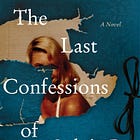Depression and Writing in the Mind of Esther Greenwood
What The Bell Jar teaches us about the complex relationship between writing and major depression
I recently re-read The Bell Jar for the first time since I was in my late teens. I was surprised to discover how little writing is mentioned in the book, because I think of it as a book about the depression a writer goes through. And it is about that but perhaps I had conflated it with Sylvia Plath’s true life story and expected there to be many more mentions of writing itself. And yet, it actually makes sense to me now that I think about it, because during depressive periods, it’s often hard to write, and so why would a book about a depressive period feature a lot of writing? And upon closer examination, there is actual regular mention of writing as it relates to her mental health. I had just forgotten how much of the story was other stuff, too.
If you’re not familiar with this semi-autobiographical novel, it begins in New York where protagonist Esther Greenwood has an internship as a fashion writer. Within the first few pages, we learn that she wants to be excited about the experience but that she “just bumped from my hotel to work and to parties and from parties to my hotel and back to work like a numb trolleybus.” I relate to these early days of a depressive period. You are doing a thing that you want to be doing but you don’t really feel happy about it and you don’t really know why and you just keep trying to distract yourself with activity hoping to feel better. My own life spun out of control with activity as I tried everything I could to not be numb in depression, something I’ve described a little bit in my book Crochet Saved My Life. There’s a scene in the book where she drags herself to go skiing even though she doesn’t want to and ends up injured and it resonated so hard for me because depression often looks like staying in bed but it’s not only that … it’s a lot of trying really hard to get up and do stuff and often having it go awry because you’re head’s not all there and then going back to bed and feeling bad about it all.
The depression started early for her, which I can relate to. Looking back, I think my first depressive period was probably in junior high school, although I wouldn’t get diagnosed or recognize it as such until my late twenties. Greenwood’s first experience of it was when her father died when she was nine, so it was grief/trauma/loss that triggered it. This excerpt stood out to me:
“How strange it had never occurred to me before that I was only purely happy until I was nine years old. After that - in spite of the Girl Scouts and the piano lessons and the sailing camp, all of which my mother scrimped to give me, and college, with crewing in the mist before breakfast and blackbottom pies and the little new firecrackers of ideas going off every day - I had never been really happy again.”

We do learn a bit about Greenwood’s writing in the early pages of the book. She gets called into her editor’s office who asks if she isn’t interested in her work and she says that no, of course she’s interested, practically yelling the words because she wanted to sound convincing. She wanted to enjoy this writing job. She says, “All my life I’d told myself studying and reading and writing and working like mad was what I wanted to do, and it actually seemed to be true …” She wrote for a local paper and a literary magazine and had scholarship offers and got this internship and had the support of “a well-known woman poet” and yet here she was living the dream and she wasn’t loving it like she felt she should. This could be a case of the wrong job. But in this instance it is depression. For me personally, pointlessness is one of the most prevalent symptoms of depression. When in depressive periods, I can’t see the point to anything, particularly my own creative work. I want to. I remember that I once did. And yet, I don’t. This is what Esther Greenwood is going through. Her editor asks her what she wants to do after graduating and she remembers that she always thought she would go to grad school and write books of poetry, maybe teach, maybe edit … but she can’t remember why she wanted to do that, she can’t actually feel the point of it.
At the same time, she feels a lot of indecision. This is another hallmark of depression for me. (Here’s some science about that; when indecision becomes pathological it’s called aboulomania.) Indecisiveness can also be a trauma response. This is depicted best by my favorite imagery in the book - the famous quote about the fig tree. Here’s that excerpt:
"I saw my life branching out before me like the green fig tree in the story. From the tip of every branch, like a fat purple fig, a wonderful future beckoned and winked. One fig was a husband and a happy home and children, and another fig was a famous poet and another fig was a brilliant professor, and another fig was Ee Gee, the amazing editor, and another fig was Europe and Africa and South America, and another fig was Constantin and Socrates and Attila and a pack of other lovers with queer names and offbeat professions, and another fig was an Olympic lady crew champion, and beyond and above these figs were many more figs I couldn't quite make out. I saw myself sitting in the crotch of this fig tree, starving to death, just because I couldn't make up my mind which of the figs I would choose. I wanted each and every one of them, but choosing one meant losing all the rest, and, as I sat there, unable to decide, the figs began to wrinkle and go black, and, one by one, they plopped to the ground at my feet."
(As an aside, the biopic Sylvia begins with this quote. As I shared in my post about falling in love with researching Plath, it’s really hard to separate out fact and fiction in Plath’s story because The Bell Jar is autobiographical fiction and often drawn from when sharing Plath’s true story. Charlotte Ahlin over at Bustle has a great article about how this quote is taken out of the context of the book and placed into the context of Plath’s life when it’s repeated but that The Bell Jar brings it to a happier place if you keep reading.)
As she gets further into the depression, her indecision worsens. “It was becoming more and more difficult for me to decide to do anything in those last days. And when I eventually did decide to do something, such as packing a suitcase, I only dragged all my grubby, expensive clothes out of the bureau and the closet and spread them on the chairs and the bed and the floor and then sat and stared at them, utterly perplexed.” This resonates so hard for me as someone with a lived experience of depression. Sylvia Plath clearly did write what she knew.

Later in the book, with Esther’s depression getting worse, there’s another scene with the editor. Everyone’s getting their photos taken with something that represents “what they want to be.” She doesn’t know what she wants to be but pressed for an answer she says a poet and the photographer asks her to smile to “show us how happy it makes you to write a poem” and she begins to sob. Everyone basically just runs out of the room and leaves her to her emotion (because people don’t know how to cope with mental health moments) and then eventually her editor comes back in with a stack of manuscripts for her to read. She starts thinking about how many manuscripts are submitted every year in a description that sounds like she’s overwhelmed, then she starts reflecting on how she’d submitted a story to a writer hoping to get into their class and she assumed she would although she hasn’t heard, yet, and then she’s fantasizing about writing her own manuscript anonymously and submitted it to her editor who would find it “a cut about the usual.” This scene reflects more of the nuance of depression. You cry and don’t know why and you find a lot of things pointless and you’re numb but there is also a lot of TRYING in depression and you don’t actually stop dreaming of the future. Your mind ruminates on so many things (will I get into that class? Am I good enough, blah blah) but also dreams and fantasizes and hopes (imagine writing the best manuscript.) In my experience, what happens then is the feeling that trying to actually do the thing would be exhausting and going back to bed. Depression isn’t one color even though it feels like it at times.
With the internship over, Esther heads home, and on the ride back her mother informs her that she did not get accepted into the aforementioned writing class. That is really the last straw for her depression, her last thing she was hoping and dreaming about taken away. She feels gutted. And this is where she goes into debilitating, immobilizing depression. She stays in bed, ignores the phone, doesn’t change out of her nightgown, stops washing her hair. Even still, though, she tries to pull herself out of it. She sets up a desk for herself, counts out 350 sheets of paper, feeds the first one into her typewriter and attempts to write. In a very meta scene, Plath’s heroine Esther (a thinly veiled version of herself) chooses to write about her own heroine, Elaine, as a thinly veiled version of herself. Notably, all of them have six letters in their name, which Esther says, “seemed like a lucky thing.”
She writes two sentences then stares at the page for an hour until her mother comes in and ask why she isn’t getting dressed. She says, “I’m writing a novel. I haven’t got time to change out of this and into that.” The next sentence that she manages to write is “Inertia oozed like molasses through Elaine’s limbs.” At this point, she realizes that she would barely write a page a day at this rate. Then she decided she can’t write because she doesn’t have experience in life so she would stop writing the novel until after she had “gone to Europe and had a lover.” So now she’ll start reading Finnegans Wake and working on her thesis. Or maybe she’ll delay college for a year and apprentice for a pottery maker. Or go to Germany to try to waitress in order to become bilingual.
I can’t reiterate enough how much I relate to these mental gymnastics of depressive periods. You really do think that maybe you will do all of these things and then immediately see reasons that you can’t and there’s this whole internal dialogue constantly going on and you feel terrible about yourself because you’re not doing anything and then the whole thought process is so exhausting that you have to go back to bed.

Then we reach this interesting point where she begins to have a lot of trouble reading and writing. Her handwriting changes. It has to do with the difficulty of concentrating and understanding when depression has taken over the brain. At this point Greenwood sees a psychiatrist who sends her to a psychiatric institution where she gets ECT and she hates it so she decides to pretend that she is fine and never go back there but she’s not fine at all. She can’t sleep. The rumination is awful. She takes every negative thing that anyone’s ever said to her and runs it over and over in her mind, some of which is related to her creativity. She hears the voice of the editor asking if she’s interested in the work. She remembers a creative writing professor who called her work factitious. It’s at this time that the book goes through all of the different ways that she contemplates and even makes some action towards dying by suicide.
At this point she is not able to read much of anything except for a singular focus on abnormal psychology books. She says, “(I) compared my symptoms with the symptoms in the books, and sure enough, my symptoms tallied with the most hopeless cases. … It was as if some slim opening had been left, so I could learn all I needed to know about my case to end it in the proper way.” Before someone dies by suicide there’s often a period of focus like this where all of the indecision stops and you feel some relief about not having to worry about the future anymore. She doesn’t have to figure out how to write. She doesn’t even have to read except to deal with this last task. The relief comes from feeling like the churning exhaustion of depression might have an end in sight. So she tries to die by suicide, she is found, and she is sent to inpatient hospital care. And then we get into my favorite part of the book as it relates to her writing and mental health …
She’s in a terrible state hospital then suddenly she’s moved to a better place. It turns out that “Philomena Guinea, the famous novelist” had taken an interest in Esther’s case, having also once been in an asylum. She contacts Esther’s mother who asks if a boy is the problem, because if so then she can’t get involved, but her mother says that no, it’s Esther’s writing that is the problem, “She thinks she will never write again.” So Mrs. Guinea helps out financially and has her go to a private place. At first, Esther doesn’t care, because she’s so depressed that she’s indifferent to where she is. But this is where she’s lucky enough to meet Doctor Nolan, her female psychiatrist. (They were super rare then and I have to note that they’re still rare. Whenever I look for a therapist, it’s easy to find one who identifies as female. Whenever I look for a psychiatrist, it’s hard to find one who isn’t male.)
Esther is resistant to Dr. Nolan at first. The doctor initially wins her over by telling her that she’s stopping her visits for a bit, something that relieves Esther who doesn’t want to see her mother, or the visiting religious women, or “the English teacher I had in high school who came and tried to teach me how to play Scrabble, because he thought it might revive my old interest in words.” Dr. Nolan had realized that the visits were triggering and put an end to them and that opens a bit of a door in their therapeutic relationship. This, along with many more small moments, eventually allows Esther to trust her enough to agree to ECT again, and this time the treatment helps her. Dr. Nolan also helps her to get birth control, which makes her feel empowered in her own life choices and further assists her healing. And then the rest of the book kind of leaves me wanting because it’s not about her writing … it’s about how she gets incrementally better, closing up some loose ends from various threads in the book, and ends with her release from the hospital. Which is of course an appropriate ending for the book but it left me with so many questions about what happens with her writing next!!
Which is perhaps why I immediately fell in love with the book The Last Confessions of Sylvia P. by Lee Kravetz because it elaborates on that part of the story.

Art and Mental Health Takeaways (or Art for Thought):
Depression can leach away your ability to see the point of doing anything, including creating. You remember that you used to enjoy writing but you don’t exactly remember why. You want to want to do it but you don’t actually want to do it.
There’s something notable here about the difference between writing and “being a writer.” Esther enjoyed writing but she also wanted to “be a writer” and that comes with a lot of pressure that gets all tangled up with the self-esteem challenges and negative rumination of depression and makes it too hard to actually write.
In that kind of depression, you also put a lot of pressure on yourself. Since she didn’t get accepted into her writing class, she determines that she’s going to write a novel. This is a daunting task that immediately seems completely impossible and therefore she can’t write at all.
Indecisiveness is a common symptom of depression. This affects many things, including, of course, creativity.
Writing/art can be an excuse not to take care of yourself. Esther says that she’s writing a novel so she can’t be bothered to get dressed. Doing (or intending to do) the creative thing feels important and can be a justification for not doing the basic things that life required in order to be healthy.
Sometimes the creative things that you love aren’t the things that are going to help you out of crisis. Like reading, which becomes hard because of lack of ability to concentrate or remember. Or learning Scrabble to make words exciting again. Esther was past that point. She needed treatment. But even if it wasn’t treatment, she might have needed something that wasn’t words. When I can’t write because of depression, I crochet or collage.
And also just a shoutout for women supporting women. It is a female benefactor that helps her get into a good hospital, a female psychiatrist who helps her, female friendships who carry her through. Of course you can have good relationships between all genders but women supporting women is a powerful thing and I personally find it particularly powerful among creative women. My female artist friends are amazing.
If you read this far, perhaps you liked the work. The work does take work. It only continues with support, so please consider subscribing. My annual rate starts at $10 per year.








Hi there.
I've been through anxiety and depression. Every little thing that you and Plath have said are so relatable. I'm so very grateful to the advance of medicine; it's medicines that saved me from what might have been a deadly fate.. I'm a LOT better now. Still on meds, to make sure there's no relapses.
What I really want is for all women who face this to find your page and feel that it ISN'T their fault for feeling inadequate, feeling directionless, not being able to focus, not being able to love, laugh, live, read, play or feel anymore.
And the people trying to discover "reasons" behind depression - it's not one or two events. It's a whole lot of experiences. Maybe some friend of yours passed a comment that was trivial to them at the moment, but it aggravated your mental state so much that that becomes part of what breaks you.
And yes, lots of people who have experienced traumas like the passing of a close relative at a young age don't become depressed. But all minds are different. You can't reason that one person's mind adjusted but another's didn't. You just don't know about every little moment that person goes through everyday.
This is real, and it needs to reach more of us who face this.